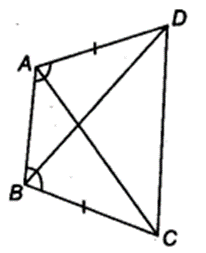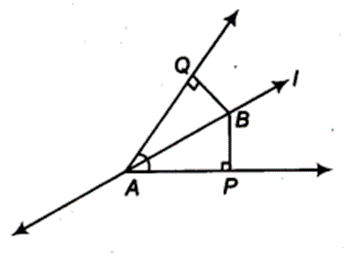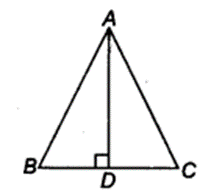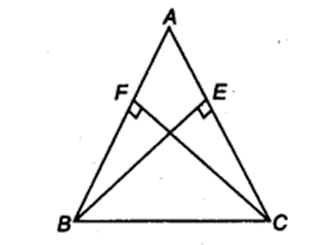Ex 7.1 Class 9 MathsQuestion 1.
In quadrilateral ACBD, AC = AD and AB bisects ∠ A (see figure). Show that ∆ABC ≅ ∆ABD. What can you say about BC and BD?

Solution:
In quadrilateral ACBD, we have AC = AD and AB being the bisector of ∠A.
Now, In ∆ABC and ∆ABD,
AC = AD (Given)
∠ CAB = ∠ DAB ( AB bisects ∠ CAB)
and AB = AB (Common)
∴ ∆ ABC ≅ ∆ABD (By SAS congruence axiom)
∴ BC = BD (By CPCT)
Ex 7.1 Class 9 Maths Question 2.
ABCD is a quadrilateral in which AD = BC and ∠ DAB = ∠ CBA (see figure). Prove that

(i) ∆ABD ≅ ∆BAC
(ii) BD = AC
(iii) ∠ABD = ∠ BAC
Solution:
In quadrilateral ACBD, we have AD = BC and ∠ DAB = ∠ CBA
(i) In ∆ ABC and ∆ BAC,
AD = BC (Given)
∠DAB = ∠CBA (Given)
AB = AB (Common)
∴ ∆ ABD ≅ ∆BAC (By SAS congruence)
(ii) Since ∆ABD ≅ ∆BAC
⇒ BD = AC [By C.P.C.T.]
(iii) Since ∆ABD ≅ ∆BAC
⇒ ∠ABD = ∠BAC [By C.P.C.T.]
Ex 7.1 Class 9 Maths Question 3.
AD and BC are equal perpendiculars to a line segment AB (see figure). Show that CD bisects AB.

Solution:
In ∆BOC and ∆AOD, we have
∠BOC = ∠AOD
BC = AD [Given]
∠BOC = ∠AOD [Vertically opposite angles]
∴ ∆OBC ≅ ∆OAD [By AAS congruency]
⇒ OB = OA [By C.P.C.T.]
i.e., O is the mid-point of AB.
Thus, CD bisects AB.
Ex 7.1 Class 9 MathsQuestion 4.
l and m are two parallel lines intersected by another pair of parallel lines p and q (see figure). Show that ∆ABC = ∆CDA.

Solution:
∵ p || q and AC is a transversal,
∴ ∠BAC = ∠DCA …(1) [Alternate interior angles]
Also l || m and AC is a transversal,
∴ ∠BCA = ∠DAC …(2)
[Alternate interior angles]
Now, in ∆ABC and ∆CDA, we have
∠BAC = ∠DCA [From (1)]
CA = AC [Common]
∠BCA = ∠DAC [From (2)]
∴ ∆ABC ≅ ∆CDA [By ASA congruency]
Ex 7.1 Class 9 Maths Question 5.
Line l is the bisector of an ∠ A and ∠ B is any point on l. BP and BQ are perpendiculars from B to the arms of LA (see figure). Show that
(i) ∆APB ≅ ∆AQB
(ii) BP = BQ or B is equidistant from the arms ot ∠A.

Solution:
We have, l is the bisector of ∠QAP.
∴ ∠QAB = ∠PAB
∠Q = ∠P [Each 90°]
∠ABQ = ∠ABP
[By angle sum property of A]
Now, in ∆APB and ∆AQB, we have
∠ABP = ∠ABQ [Proved above]
AB = BA [Common]
∠PAB = ∠QAB [Given]
∴ ∆APB ≅ ∆AQB [By ASA congruency]
Since ∆APB ≅ ∆AQB
⇒ BP = BQ [By C.P.C.T.]
i. e., [Perpendicular distance of B from AP]
= [Perpendicular distance of B from AQ]
Thus, the point B is equidistant from the arms of ∠A.
Ex 7.1 Class 9 Maths Question 6.
In figure, AC = AE, AB = AD and ∠BAD = ∠EAC. Show that BC = DE.

Solution:
We have, ∠BAD = ∠EAC
Adding ∠DAC on both sides, we have
∠BAD + ∠DAC = ∠EAC + ∠DAC
⇒ ∠BAC = ∠DAE
Now, in ∆ABC and ∆ADE. we have
∠BAC = ∠DAE [Proved above]
AB = AD [Given]
AC = AE [Given]
∴ ∆ABC ≅ ∆ADE [By SAS congruency]
⇒ BC = DE [By C.P.C.T.]
Ex 7.1 Class 9 Maths Question 7.
AS is a line segment and P is its mid-point. D and E are points on the same side of AB such that ∠ BAD = ∠ ABE and ∠ EPA = ∠ DPB. (see figure). Show that
(i) ∆DAP ≅ ∆EBP
(ii) AD = BE

Solution:
We have, P is the mid-point of AB.
∴ AP = BP
∠EPA = ∠DPB [Given]
Adding ∠EPD on both sides, we get
∠EPA + ∠EPD = ∠DPB + ∠EPD
⇒ ∠APD = ∠BPE
(i) Now, in ∆DAP and ∆EBP, we have
∠PAD = ∠PBE [ ∵∠BAD = ∠ABE]
AP = BP [Proved above]
∠DPA = ∠EPB [Proved above]
∴ ∆DAP ≅ ∆EBP [By ASA congruency]
(ii) Since, ∆ DAP ≅ ∆ EBP
⇒ AD = BE [By C.P.C.T.]
Ex 7.1 Class 9 Maths Question 8.
In right triangle ABC, right angled at C, M is the mid-point of hypotenuse AB. C is joined to M and produced to a point D such that DM = CM. Point D is joined to point B (see figure). Show that
(i) ∆AMC ≅ ∆BMD
(ii) ∠DBC is a right angle
(iii) ∆DBC ≅ ∆ACB

(iv) CM = 12 AB
Solution:
Since M is the mid – point of AB.
∴ BM = AM
(i) In ∆AMC and ∆BMD, we have
CM = DM [Given]
∠AMC = ∠BMD [Vertically opposite angles]
AM = BM [Proved above]
∴ ∆AMC ≅ ∆BMD [By SAS congruency]
(ii) Since ∆AMC ≅ ∆BMD
⇒ ∠MAC = ∠MBD [By C.P.C.T.]
But they form a pair of alternate interior angles.
∴ AC || DB
Now, BC is a transversal which intersects parallel lines AC and DB,
∴ ∠BCA + ∠DBC = 180° [Co-interior angles]
But ∠BCA = 90° [∆ABC is right angled at C]
∴ 90° + ∠DBC = 180°
⇒ ∠DBC = 90°
(iii) Again, ∆AMC ≅ ∆BMD [Proved above]
∴ AC = BD [By C.P.C.T.]
Now, in ∆DBC and ∆ACB, we have
BD = CA [Proved above]
∠DBC = ∠ACB [Each 90°]
BC = CB [Common]
∴ ∆DBC ≅ ∆ACB [By SAS congruency]
(iv) As ∆DBC ≅ ∆ACB
DC = AB [By C.P.C.T.]
But DM = CM [Given]
∴ CM = 12DC = 12AB
⇒ CM = 12AB
Ex 7.2 Class 9 Maths Question 1.
In an isosceles triangle ABC, with AB = AC, the bisectors of ∠B and ∠C intersect each other at 0. Join A to 0. Show that
(i) OB = OC
(ii) AO bisects ∠A
Solution:
i) in ∆ABC, we have
AB = AC [Given]
∴ ∠ABC = ∠ACB [Angles opposite to equal sides of a A are equal]

⇒ 12∠ABC = 12∠ACB
or ∠OBC = ∠OCB
⇒ OC = OB [Sides opposite to equal angles of a ∆ are equal]
(ii) In ∆ABO and ∆ACO, we have
AB = AC [Given]
∠OBA = ∠OCA [ ∵12∠B = 12∠C]
OB = OC [Proved above]
∆ABO ≅ ∆ACO [By SAS congruency]
⇒ ∠OAB = ∠OAC [By C.P.C.T.]
⇒ AO bisects ∠A.
Ex 7.2 Class 9 Maths Question 2.
In ∆ABC, AD is the perpendicular bisector of BC (see figure). Show that ∆ ABC is an isosceles triangle in which AB = AC.

Solution:
Since AD is bisector of BC.
∴ BD = CD
Now, in ∆ABD and ∆ACD, we have
AD = DA [Common]
∠ADB = ∠ADC [Each 90°]
BD = CD [Proved above]
∴ ∆ABD ≅ ∆ACD [By SAS congruency]
⇒ AB = AC [By C.P.C.T.]
Thus, ∆ABC is an isosceles triangle.
Ex 7.2 Class 9 Maths Question 3.
ABC is an isosceles triangle in which altitudes BE and CF are drawn to equal sides AC and AB respectively (see figure). Show that these altitudes are equal.

Solution:
∆ABC is an isosceles triangle.
∴ AB = AC
⇒ ∠ACB = ∠ABC [Angles opposite to equal sides of a A are equal]
⇒ ∠BCE = ∠CBF
Now, in ∆BEC and ∆CFB
∠BCE = ∠CBF [Proved above]
∠BEC = ∠CFB [Each 90°]
BC = CB [Common]
∴ ∆BEC ≅ ∆CFB [By AAS congruency]
So, BE = CF [By C.P.C.T.]
Ex 7.2 Class 9 Maths Question 4.
ABC is a triangle in which altitudes BE and CF to sides AC and AB are equal (see figure).

Show that
(i) ∆ABE ≅ ∆ACF
(ii) AB = AC i.e., ABC is an isosceles triangle.
Solution:
(i) In ∆ABE and ∆ACE, we have
∠AEB = ∠AFC
[Each 90° as BE ⊥ AC and CF ⊥ AB]
∠A = ∠A [Common]
BE = CF [Given]
∴ ∆ABE ≅ ∆ACF [By AAS congruency]
(ii) Since, ∆ABE ≅ ∆ACF
∴ AB = AC [By C.P.C.T.]
⇒ ABC is an isosceles triangle.
Ex 7.2 Class 9 Maths Question 5.
ABC and DBC are isosceles triangles on the same base BC (see figure). Show that ∠ ABD = ∠ACD.

Solution:
In ∆ABC, we have
AB = AC [ABC is an isosceles triangle]
∴ ∠ABC = ∠ACB …(1)
[Angles opposite to equal sides of a ∆ are equal]
Again, in ∆BDC, we have
BD = CD [BDC is an isosceles triangle]
∴ ∠CBD = ∠BCD …(2)
[Angles opposite to equal sides of a A are equal]
Adding (1) and (2), we have
∠ABC + ∠CBD = ∠ACB + ∠BCD
⇒ ∠ABD = ∠ACD.
Download Mennta App and get access to free video lectures and hand crafted notes.